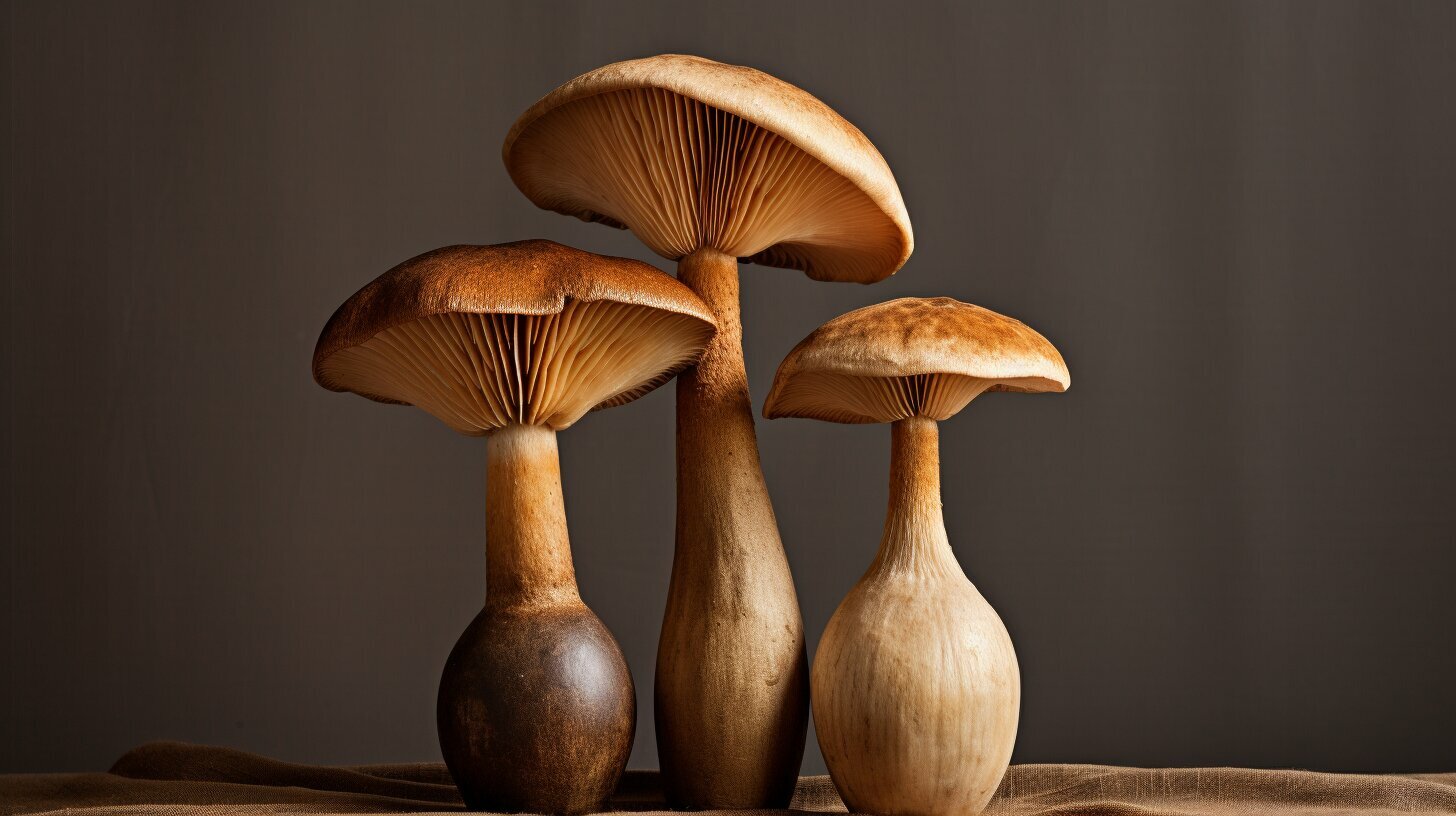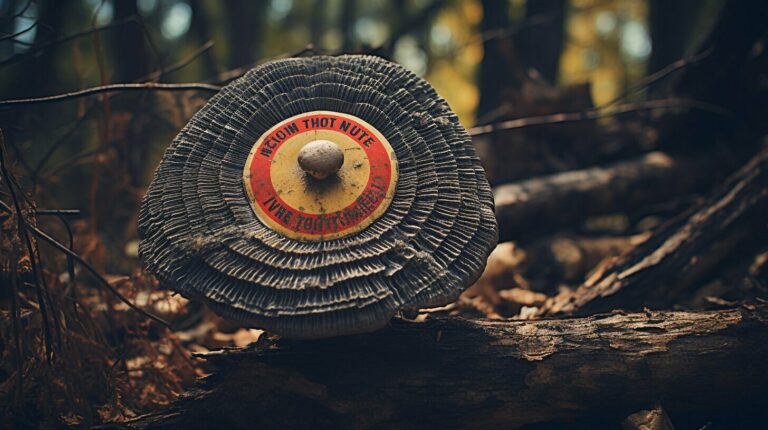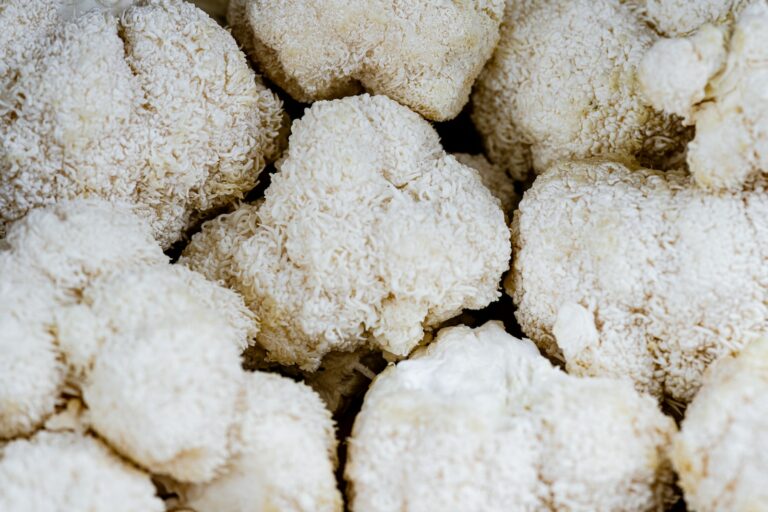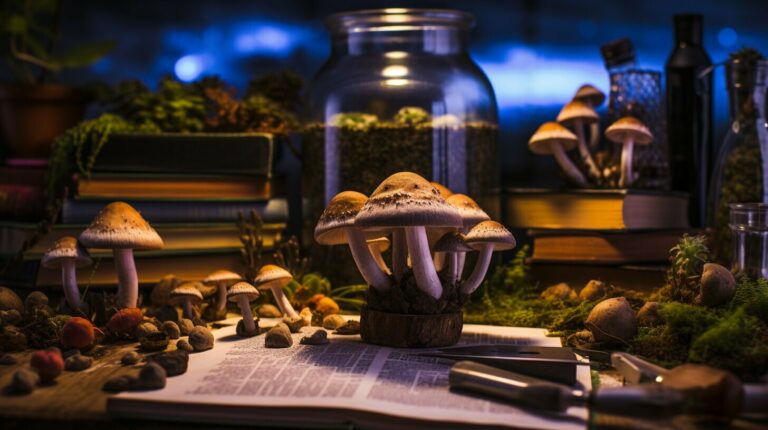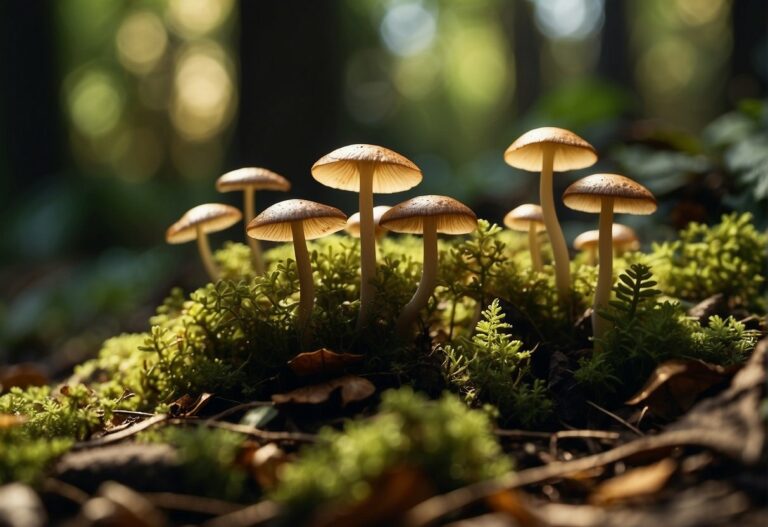Welcome to the fascinating world of mushroom shapes! In this guide, we will explore the captivating array of silhouettes found in nature’s wonderland.
- The cap shape of a mushroom is a crucial feature for identification.
- Different cap shapes can narrow down the possibilities and aid in classification.
- Common cap shapes include convex, cuspidate, cone-shaped, and bell-shaped.
- Mushroom caps can have scales or be smooth, contributing to their overall appearance.
- The undersides of mushroom caps can have gills, pores, ridges, or teeth, which are involved in spore production and dispersal.
Importance of Cap Shape for Identification
Table of Contents
The cap shape of a mushroom plays a vital role in identification, as it can provide valuable clues about the species or help narrow down the options. Different mushroom species have distinct cap shapes, which can range from convex to cone-shaped, bell-shaped, and more. This diversity in cap shapes allows mycologists and enthusiasts to differentiate between various mushrooms and classify them accordingly.
One of the reasons cap shape is essential for identification is because it is one of the most noticeable features of a mushroom. When observing a mushroom, the shape of its cap is often the first characteristic that catches the eye. By understanding the different cap shapes and their unique characteristics, individuals can make more informed decisions when trying to identify a particular mushroom species.
Additionally, cap shape can help in narrowing down the possibilities when identifying mushrooms. For example, if a mushroom has a cone-shaped cap, it becomes easier to exclude species with bell-shaped or convex caps. This simplifies the identification process and reduces the time and effort required to determine the species.
To further illustrate the importance of cap shape for identification, let’s take a closer look at some common cap shapes in mushrooms:
Common Cap Shapes in Mushrooms
| Cap Shape | Description |
|---|---|
| Convex | A cap that is rounded and bumps upward, often resembling an umbrella. |
| Cuspidate (Witch-hat) | A cap with a pointed or conical shape, similar to a witch’s hat. |
| Cone-shaped | A cap that tapers to a point, resembling a traffic cone. |
| Bell-shaped | A cap that is flared outward, resembling the shape of a bell. |
These are just a few examples of common cap shapes found in mushrooms. By studying and understanding these different shapes, individuals can develop a more comprehensive knowledge of mushroom identification.
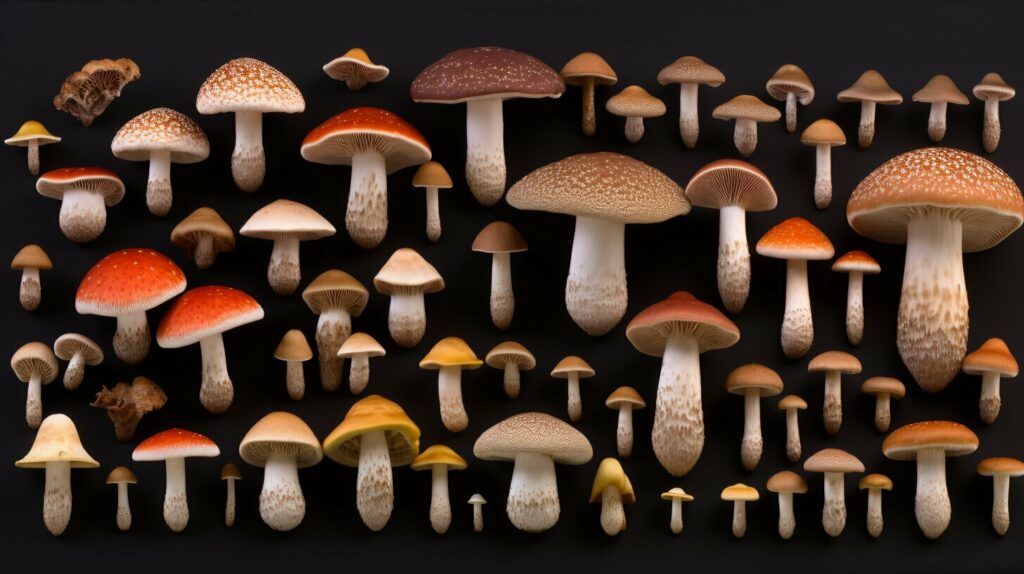
Common Cap Shapes
Mushroom caps come in a multitude of shapes, ranging from convex to cuspidate, cone-shaped, bell-shaped, and beyond. These unique cap shapes play a significant role in identifying mushroom species and understanding their diverse characteristics. Let’s explore some of the most common cap shapes found in the fascinating world of mushrooms.
Convex:
The convex shape is one of the most recognizable and frequently encountered cap shapes. It features a rounded, dome-like cap that is slightly curved upwards and typically covers the gills or spore-bearing structures found underneath. You can imagine it as a small umbrella protecting the delicate inner parts of the mushroom.
Cuspidate (Witch-Hat):
The cuspidate cap shape is truly enchanting, resembling a pointed hat often associated with witches. It has a conical or pointed shape, with the tip of the cap extending beyond the stem. This captivating shape can be observed in various mushroom species and adds a touch of whimsy to the forest floor.
Cone-Shaped:
As the name suggests, the cone-shaped cap resembles an upside-down cone or a geometric cone with a pointed top and a wider base. This shape is often elongated and tapers towards the top, creating an elegant silhouette. Cone-shaped mushrooms are a feast for the eyes, adding a graceful touch to their surroundings.
Bell-Shaped:
The bell-shaped cap is another captivating form commonly found in mushrooms. It is characterized by a broad, convex shape that gradually expands outwards and then curves back inwards, resembling the shape of a bell. This shape is often associated with mushrooms that grow in groups or clusters, creating a charming visual display.
| Cap Shape | Description |
|---|---|
| Convex | Rounded, dome-like cap |
| Cuspidate (Witch-Hat) | Pointed cone-like shape, resembling a witch’s hat |
| Cone-Shaped | Upside-down cone or geometric cone shape |
| Bell-Shaped | Broad, convex shape that curves inwards like a bell |
These are just a few examples of the diverse cap shapes found in the mushroom kingdom. Each shape offers a unique glimpse into the variety and wonder of nature. Remember to observe and appreciate the magnificent mushroom shapes during your next nature walk, and let the beauty of these intricate fungi captivate your imagination.
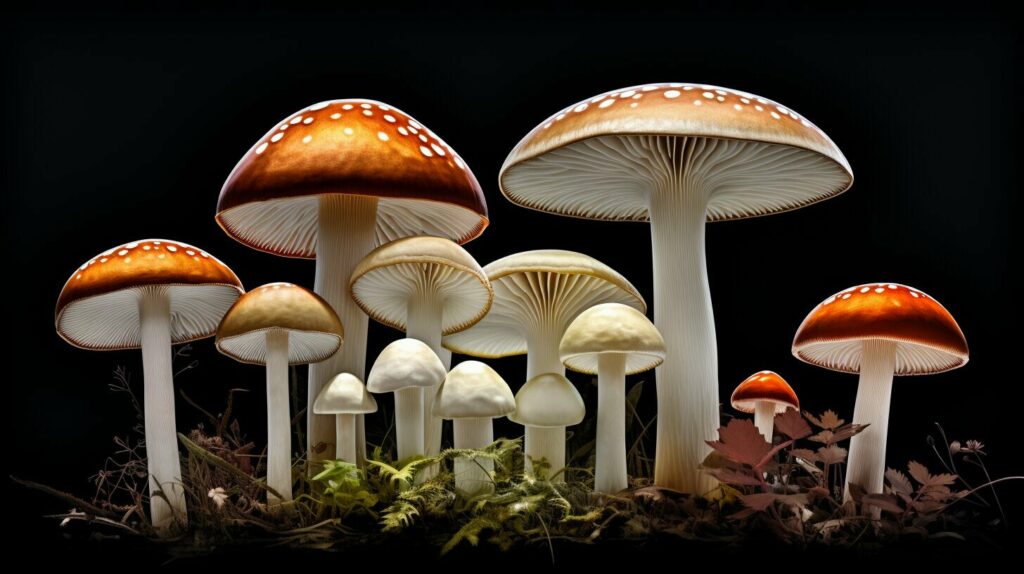
Mushroom caps can display a fascinating range of textures, from the presence of delicate scales to a smooth and glossy surface. The cap surface is an important characteristic in identifying and classifying mushroom species. It contributes to the overall appearance of the mushroom, providing valuable clues for identification.
“The cap surface of a mushroom can be compared to a painter’s canvas, showcasing intricate patterns and textures that captivate the eye. Some mushrooms feature scales, which appear like delicate pieces of lace adorning the cap, while others have a smooth and seamless surface that reflects light, giving it a glossy appearance.”
Scale-covered caps, also known as squamulose, can have various patterns and shapes. The scales may be arranged concentrically or radially, creating stunning visual designs. These scales can be colored differently from the cap, adding to the mushroom’s aesthetic appeal. On the other hand, smooth caps provide a sleek and polished look, with a surface that reflects the surrounding environment.
To illustrate the diverse cap surface variations, let’s take a closer look at two mushroom species: the Amanita muscaria and the Amanita phalloides. The Amanita muscaria features a bright red cap with white scales, creating a striking appearance reminiscent of an artist’s masterpiece. In contrast, the Amanita phalloides exhibits a smooth and glossy greenish cap, giving it an alluring and sophisticated presence.
| Mushroom Species | Cap Surface |
|---|---|
| Amanita muscaria | Scales |
| Amanita phalloides | Smooth and glossy |
Understanding the cap surface variation is essential in mushroom identification. By observing and noting the presence of scales or smoothness, along with other characteristics, such as cap color and shape, fungal enthusiasts and researchers can unlock the secrets of these fascinating organisms.
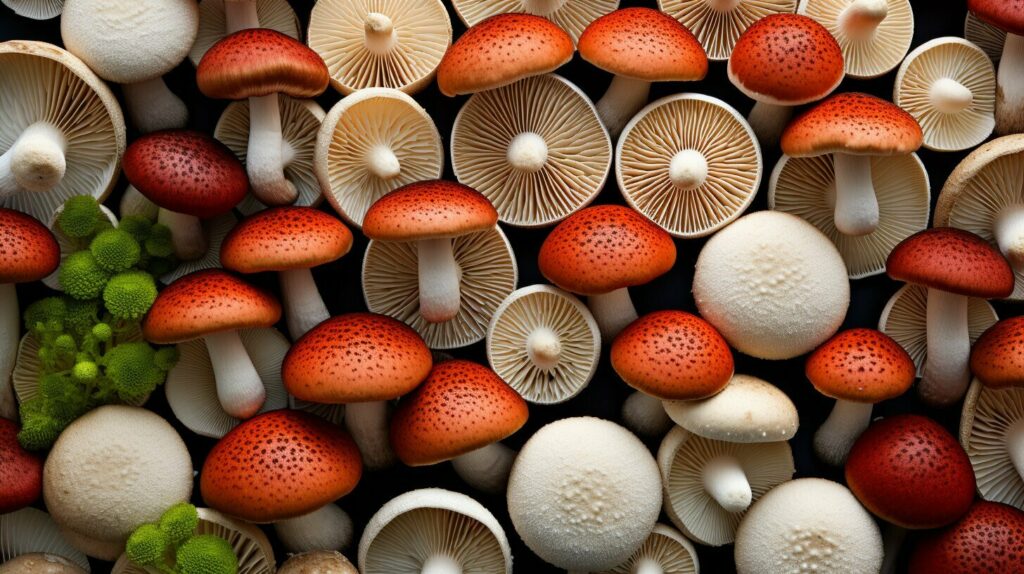
The undersides of mushroom caps reveal an intricate network of structures, including gills, pores, ridges, or teeth, which play a crucial role in the fungi’s reproductive process. These features are distinctive and provide important clues for identification and classification of mushroom species. Let’s take a closer look at each of these fascinating structures:
Gills
Gills are thin, blade-like structures that radiate from the central stalk of the mushroom cap. They are responsible for spore production and dispersal. The arrangement and color of the gills can vary greatly between different mushroom species, making them a key characteristic for identification.
Pores
Some mushrooms, instead of having gills, have small pores on their undersides. These pores release the spores, which are then carried away by air currents. The size, shape, and color of the pores are important features in species differentiation.
Ridges and Teeth
While gills and pores are the most common structures found on mushroom undersides, some species have ridges or teeth-like formations. These ridges and teeth serve the same purpose as gills and pores, aiding in spore dispersal. They can take on various shapes and sizes, adding to the diversity of mushroom forms.
Understanding the characteristics of these underside features is essential for mushroom enthusiasts, for it allows them to identify and appreciate the incredible diversity of fungi in their natural habitats. So, the next time you stumble upon a mushroom, don’t forget to take a peek underneath its cap and marvel at the intricate structures that contribute to its beauty and reproductive success.
| Structure | Description |
|---|---|
| Gills | Thin, blade-like structures that radiate from the stalk of the mushroom cap. Responsible for spore production and dispersal. |
| Pores | Small openings on the mushroom’s undersides that release spores. Spores are carried away by air currents. |
| Ridges and Teeth | Alternate structures to gills and pores, aiding in spore dispersal. Can take on various shapes and sizes. |
Spore Dispersal
Mushroom spores, tiny reproductive cells, are dispersed through various methods, such as gills, pores, or teeth. These microscopic spores play a vital role in the reproduction and survival of fungi. While the exact method of dispersal varies between mushroom species, the ultimate goal remains the same: to ensure the widespread distribution of spores for successful reproduction.
One common method of spore dispersal is through gills, thin structures found underneath the cap of many mushrooms. The gills act as a platform for spore production, with countless spores being released into the surrounding environment. As air currents pass over the gills, the spores are carried away, allowing them to potentially land in suitable habitats for growth and germination.
Another method of spore dispersal is through pores. Some mushrooms, such as the popular edible boletes, have a porous undersurface instead of gills. These pores function similarly to gills, releasing spores that can be carried away by air movement.
Teeth or ridges are yet another way mushrooms disperse spores. Certain species, like the hedgehog mushroom, possess short teeth on the undersides of their caps. These teeth hold the spores and aid in their dispersal, ensuring they are released when conditions are favorable.
| Spore Dispersal Methods | Examples of Mushrooms |
|---|---|
| Gills | Agaricus bisporus (Button mushroom) |
| Pores | Boletus edulis (Porcini mushroom) |
| Teeth | Hydnum repandum (Hedgehog mushroom) |
Understanding the mechanisms behind spore dispersal is crucial for both mushroom enthusiasts and scientists studying fungal ecology. By recognizing the different methods mushrooms employ to release their spores, we can gain a deeper appreciation for the intricate mechanisms that enable fungi to proliferate and thrive in diverse environments.
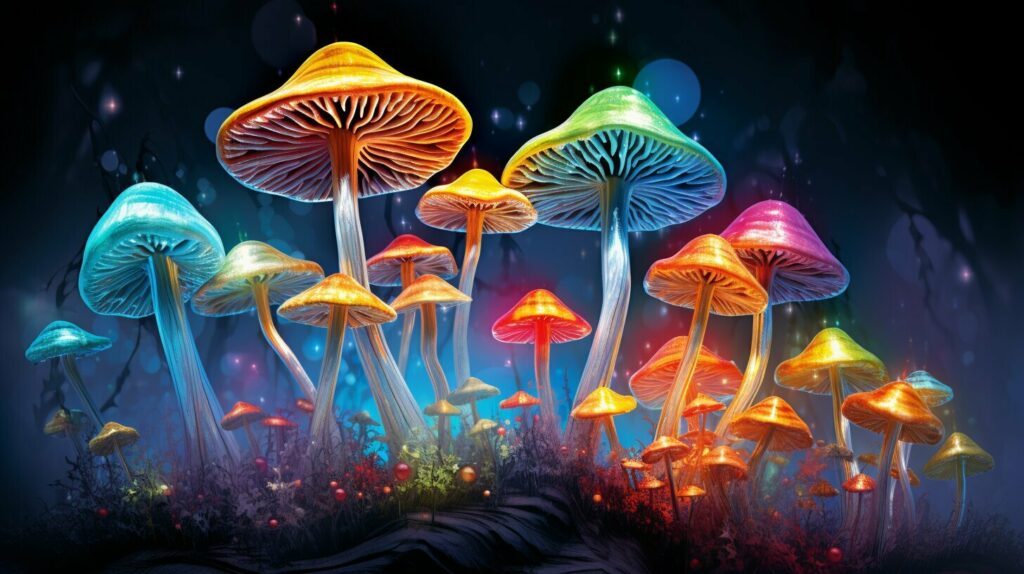
Some mushrooms display extraordinary shapes, like the lion’s mane mushroom with its cascading hair-like structures, or the hedgehog mushroom, featuring short teeth. These unique features make these mushrooms stand out in the world of fungi.
The lion’s mane mushroom (Hericium erinaceus) is a remarkable species known for its striking appearance. Its long, flowing, white or pale yellow spines resemble a lion’s mane, hence its name. This mushroom can grow to impressive sizes and is often found on decaying trees in temperate forests. The lion’s mane mushroom is not only visually captivating but also holds potential medicinal benefits. It has been used in traditional medicine for centuries and is believed to have neuroprotective and anti-inflammatory properties.
The hedgehog mushroom (Hydnum repandum) is another fascinating species with its distinctive tooth-like spines. These spines cover the underside of its cap, giving it a unique appearance. The hedgehog mushroom is typically found in woodland areas, often near coniferous trees. It is edible and highly sought after by mushroom enthusiasts for its delicate flavor and versatility in culinary applications. Its spines, which are shorter and stouter compared to other toothed mushrooms, make it easy to distinguish in the wild.
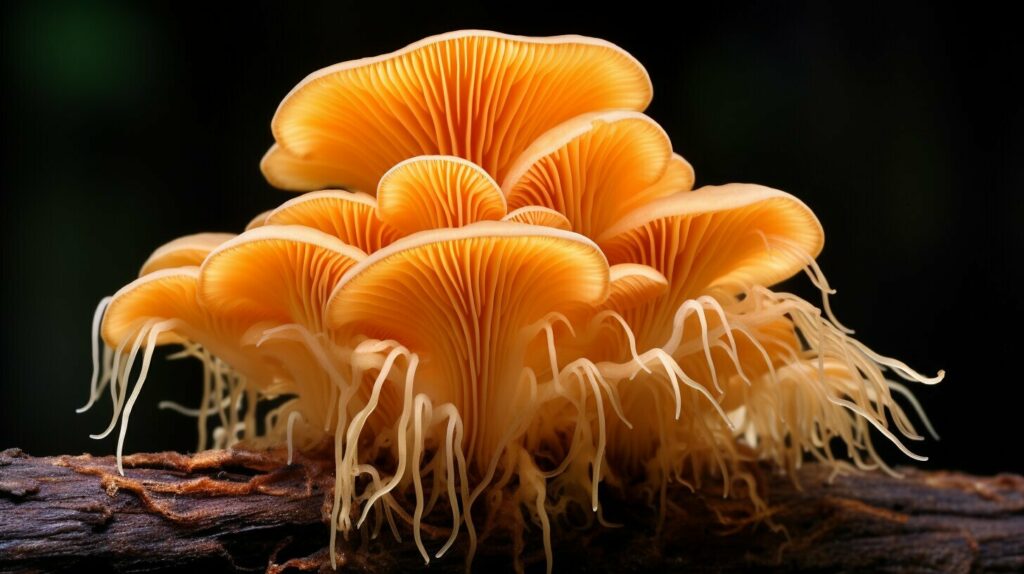
These unique mushroom shapes are just a glimpse into the vast diversity that can be found in the fungal kingdom. From towering stinkhorns to elegant coral fungi, the world of mushrooms never fails to amaze. Exploring different shapes and structures not only provides an opportunity to appreciate nature’s artistry but also deepens our understanding of the intricate lives of fungi.
Complex Anatomy of Mushrooms
The anatomy of mushrooms is intricate and varied, with different shapes and structures fulfilling specific functions in the fungi’s life cycle. Understanding the complex anatomy of mushrooms is essential for identification, as it provides valuable insights into their classification and ecological role.
The cap of a mushroom, also known as the pileus, comes in various shapes, each with its own significance. Some common cap shapes include convex, which is rounded and bulging; cuspidate or witch-hat, characterized by a pointed or cone-shaped cap; and bell-shaped, which resembles a bell or inverted cone. These shapes are influenced by genetic factors and environmental conditions, and they play a crucial role in distinguishing different mushroom species.
The diversity of cap shapes in mushrooms is truly remarkable. From the elegant spreading shapes of the parasol mushroom to the distinctive conical caps of the fly agaric, each shape tells a unique story of adaptation and survival.
Beneath the cap, the gills, pores, ridges, or teeth on the mushroom’s undersides serve as structures for spore production and dispersal. Gills are thin, blade-like structures that radiate from the stem, while pores are small openings that release spores in a polypore fungus. Ridges and teeth can be found in certain species, providing additional support for spore production. These diverse undersides contribute to the overall beauty and functionality of mushrooms.
| Cap Shape | Examples |
|---|---|
| Convex | Button mushroom, common field mushroom |
| Cuspidate (Witch-hat) | Blackening waxcap, wood blewit |
| Bell-shaped | Chanterelle, death cap |
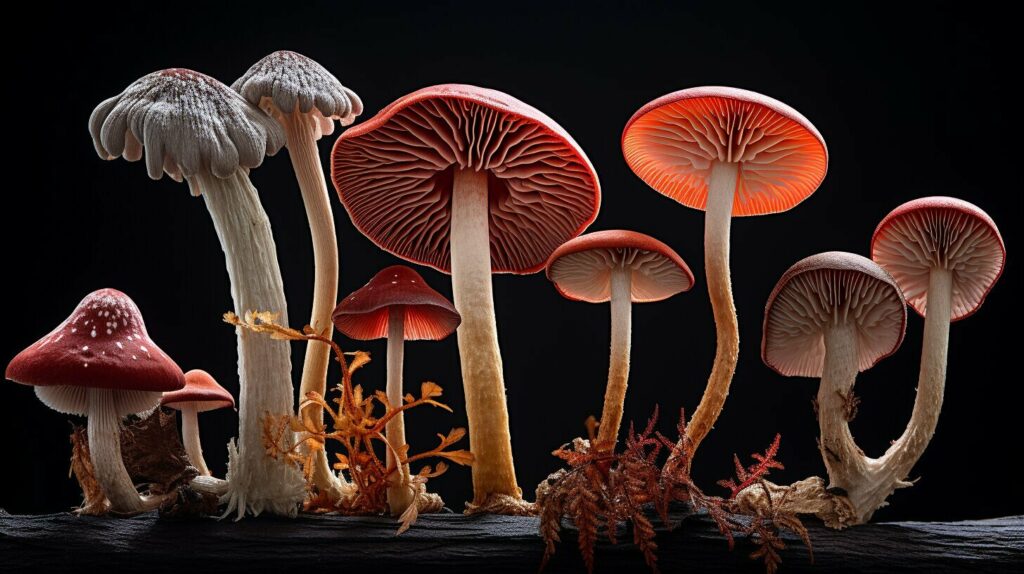
The intricate anatomy of mushrooms goes beyond cap shape and undersides. It extends to the stem, which provides support and carries nutrients throughout the organism. The stem can be cylindrical, club-shaped, or bulbous, depending on the species. Additionally, mushrooms may have a ring or annulus, a structure encircling the stem like a collar, or a volva, a cup-shaped or sack-like structure at the base of the stem.
As we unravel the complexities of mushroom anatomy, we gain a deeper appreciation for the wonders of the natural world. From the delicate beauty of the gills to the robustness of the stem, every structure serves a purpose in the fascinating life cycle of these fungi.
Exploring the World of Mushroom Shapes
Get ready to embark on a captivating journey through the myriad of mushroom shapes that adorn the natural world. These fascinating fungi showcase a stunning array of diverse silhouettes, each possessing its own unique charm and significance.
From the classic convex shape to the whimsical witch-hat or the elegant cone-shaped caps, mushrooms come in a multitude of captivating forms. Some display bell-shaped caps, while others boast intricate patterns of ridges and teeth. The mushroom kingdom is truly a treasure trove of shapes, offering an enchanting visual feast for nature lovers and enthusiasts alike.
But it’s not just about aesthetics. The shapes of mushroom caps serve a vital purpose in the identification and classification of species. The presence of scales or smoothness on the cap surface, along with the features found on the undersides, such as gills, pores, ridges, or teeth, all play a role in determining the mushroom’s identity. These features are intricately involved in spore production and dispersal, ensuring the continued existence and evolution of these remarkable organisms.
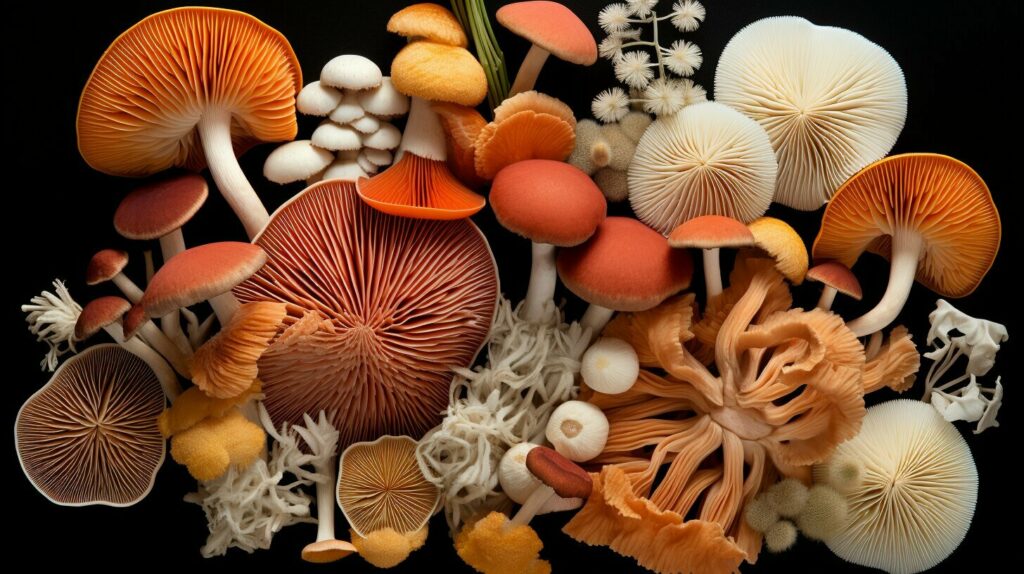
In addition to the common cap shapes, some mushrooms exhibit extraordinary forms that stand out in the fungal world. The lion’s mane mushroom, with its cascading hair-like structures, or the hedgehog mushroom, adorned with short teeth, are just a few examples of the stunning diversity found among mushroom shapes. These unique shapes not only capture our imagination but also serve as a testament to the incredible adaptability and ingenuity of nature.
As we explore the world of mushroom shapes, we gain insight into the intricate anatomy of these fungi. Each shape and structure of a mushroom plays a specific function in its life cycle, contributing to its survival and reproduction. From the cap to the stem, and the gills to the spores, every part of a mushroom has a purpose, forming a complex and interconnected system that continues to fascinate scientists and enthusiasts alike.
The Importance of Mushroom Shape Preservation
Preserving mushroom shapes is crucial for conservation efforts, considering the potential impact of environmental factors on their existence. The diverse shapes of mushrooms not only contribute to their visual appeal but also serve as key identifiers for different species. By understanding and protecting these unique shapes, we can better safeguard the biodiversity of fungi and the ecosystems they inhabit.
Mushroom shapes provide valuable information about the species and their ecological roles. The cap shape, for instance, can indicate specific mushroom families or narrow down potential identification options. From the classic convex shape to the enchanting cone-shaped or bell-shaped structures, each cap shape represents a distinct attribute that aids in classification and understanding the diverse mushroom kingdom.
The preservation of mushroom shapes is intertwined with the conservation of their habitats. As environmental factors come into play, such as habitat loss, pollution, or climate change, the delicate balance that supports mushroom growth and diversity can be disrupted. By protecting these ecosystems, we can safeguard not only the mushroom shapes but also the intricate web of interactions and dependencies they are part of.
To illustrate the importance of mushroom shape preservation, consider the following quote from renowned mycologist Paul Stamets:
“Mushrooms are the visible manifestations of a much deeper mycelial network—an interconnected web of life that provides nutrients, communicates, and supports the health of ecosystems. By preserving their shapes, we are protecting the guardians of our natural world.”
This profound statement highlights how the preservation of mushroom shapes goes beyond their aesthetic value; it ensures the conservation of entire ecosystems and the invaluable services they provide.
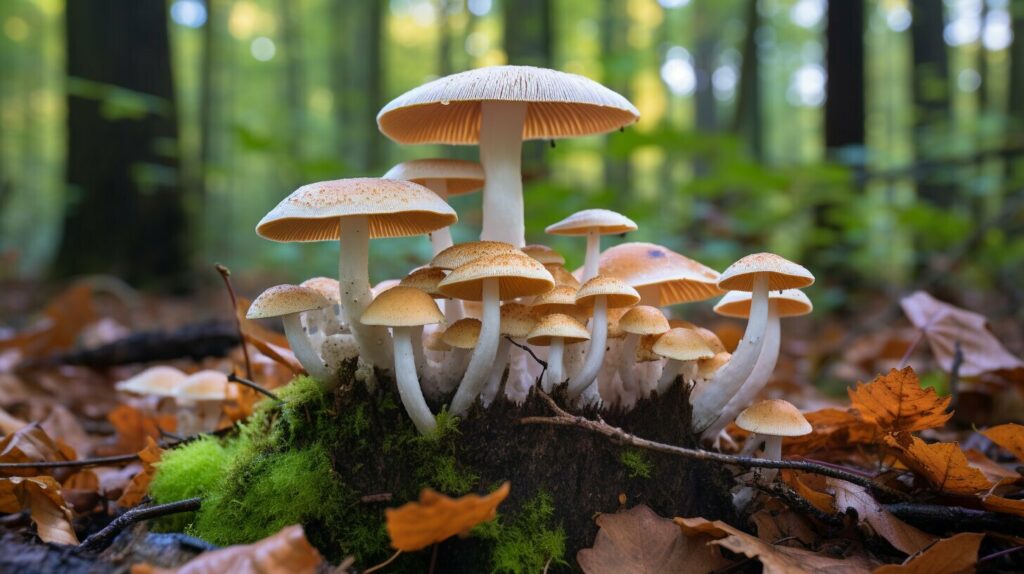
Preserving mushroom shapes is a call to action for individuals, communities, and policymakers alike. By prioritizing the conservation of these remarkable organisms and their diverse forms, we can contribute to the preservation of our natural heritage and the delicate balance of our ecosystems.
Ethnobotanical Significance of Mushroom Shapes
Mushroom shapes hold ethnobotanical significance, with cultural and traditional uses dating back through history. These unique shapes have captured the imaginations of people across cultures, inspiring stories, art, and even culinary traditions.
In many indigenous cultures, mushrooms have long been revered for their medicinal properties and spiritual symbolism. Certain mushroom shapes are believed to possess specific healing properties and are used in traditional herbal medicine. For example, the distinctive lion’s mane mushroom, with its cascading white “hair-like” structures, has been used in traditional Chinese medicine for centuries to support brain health and enhance cognitive abilities.
Furthermore, mushroom shapes have also influenced artistic expression. Painters, sculptors, and craftsmen have drawn inspiration from the fascinating forms and textures of mushrooms, incorporating their shapes into their creative works. The intricate patterns of gills, ridges, and pores found on mushroom caps have been depicted in various forms of art, highlighting the beauty and diversity of nature’s designs.
Moreover, mushroom shapes play a role in culinary traditions worldwide. Chefs and food enthusiasts appreciate the aesthetic appeal of mushrooms, often selecting them for their unique shapes to create visually stunning dishes. The delicate and intricate structures found on mushroom caps can add texture and depth to a plate, elevating both the visual and culinary experience.
“Mushroom shapes have captivated artists, healers, and chefs for centuries, weaving themselves into the fabric of cultural and traditional practices.”
Overall, the ethnobotanical significance of mushroom shapes can be found in their diverse cultural and traditional uses. From medicine to art to cuisine, these captivating forms continue to enrich our lives, reminding us of the intricate beauty and interconnectedness of the natural world.
Mushroom Shape Inspiration
The unique shapes and structures found in mushrooms have inspired artists and designers throughout history. Their organic and often otherworldly forms have been celebrated in various artistic mediums, from paintings to sculptures to fashion.
| Mushroom Shape | Inspired Art Form |
|---|---|
| Cone-shaped | Abstract sculpture |
| Bell-shaped | Botanical illustrations |
| Convex | Photography |
| Cuspidate (witch-hat) | Fashion design |
| Unique structures (e.g., lion’s mane, hedgehog) | Mixed media installations |
Artists have found inspiration in the textures, colors, and intricate details of mushroom shapes, translating their beauty into visual representations. The whimsical forms and striking structures have become a wellspring of creativity, reminding us that even the smallest organisms can hold immense artistic significance.
Conclusion
In conclusion, exploring mushroom shapes unveils a mesmerizing world that aids in species identification and provides insights into the intricate nature of fungi. The cap shape of a mushroom plays a key role in distinguishing different species and narrowing down possibilities. Mushrooms can have a wide range of cap shapes, including convex, cuspidate (witch-hat), cone-shaped, bell-shaped, and more. These distinct shapes not only add to their aesthetic appeal but also serve as important characteristics for classification.
Furthermore, the surface of mushroom caps can vary, with some having scales while others are smooth. The presence of scales or smoothness adds to the overall appearance of the mushroom and contributes to its identification. Additionally, the undersides of mushroom caps exhibit various features such as gills, pores, ridges, or teeth. These structures are involved in spore production and dispersal, as the microscopic mushroom spores need a means of being released into the environment.
Spore dispersal in mushrooms occurs through different mechanisms, including the use of gills, pores, or teeth. These structures play a crucial role in releasing the spores and ensuring the fungi’s reproductive success. Some mushrooms even boast unique shapes that make them stand out, like the lion’s mane mushroom with its fascinating hair-like structures or the hedgehog mushroom with its distinctive short teeth.
Overall, the complex anatomy of mushrooms showcases a multitude of shapes and structures, each serving a specific function in the fungi’s life cycle. Exploring the diverse world of mushroom shapes not only expands our knowledge of these fascinating organisms but also highlights the importance of their preservation. By understanding and appreciating the intricacies of mushroom shapes, we can better conserve these organisms and recognize their ethnobotanical significance throughout history.
FAQ
Q: What is the importance of cap shape for mushroom identification?
A: Cap shape is an important feature for identifying mushrooms as it can help narrow down the possibilities and indicate the species.
Q: What are some common cap shapes found in mushrooms?
A: Common cap shapes in mushrooms include convex, cuspidate (witch-hat), cone-shaped, bell-shaped, and more.
Q: Do mushroom caps have different surface textures?
A: Yes, mushroom caps can have scales or be smooth, resulting in different surface textures.
Q: What features can be found on the undersides of mushroom caps?
A: The undersides of mushroom caps can have gills, pores, ridges, or teeth, which are used for spore production and dispersal.
Q: How do mushrooms disperse their spores?
A: Mushrooms disperse their spores through the use of gills, pores, or teeth, allowing the microscopic reproductive cells to be spread.
Q: Are there mushrooms with unique shapes?
A: Yes, some mushrooms have unique shapes, such as the lion’s mane mushroom with its hair-like structures or the hedgehog mushroom with its short teeth.
Q: What does the complex anatomy of mushrooms involve?
A: The complex anatomy of mushrooms involves different shapes and structures that serve various functions in the fungi’s life cycle.

